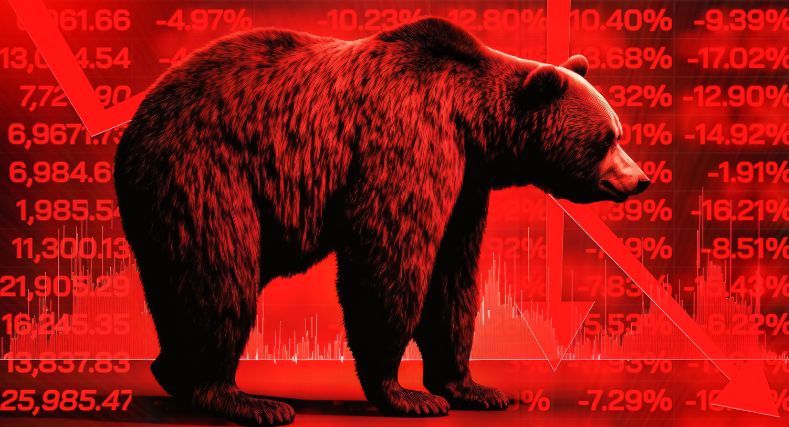How to Survive a Bear Market
What is a Bear Market?
A Bear Market can be scary, especially if you're a new investor. If you invested your money when the market was prospering and the first stop on your financial journey was falling prices, you may get discouraged easily. The reality is the stock market is constantly fluctuating, and yet historically it always grows in the long term. More importantly, there are lots of ways to navigate a market downturn in your favor if you're already invested, and there's no better time to buy in than when prices are low.

Let's start with defining what a bear market is. A bear market, or a stock market downturn, is a period marked by falling stock prices and a generally pessimistic attitude among investors. This typically occurs when there's a notable drop of 20% or more in stock prices from recent highs, across several of the key market indexes such as the Dow Jones Industrial Average or the S&P 500, over a two-month span. During such periods, market sentiment is negative, with investors anticipating further price declines.
Understanding market dynamics, particularly the shifts between bull and bear markets, is essential for any investor. These dynamics reflect the economic health and business cycles, which impact the profitability of companies and, subsequently, the value of stocks. In a bull market, when the economy is doing well and sentiment is optimistic, stock prices rise. Investors can benefit from this upward trend by buying stocks early and selling them at higher prices.
Conversely, a bear market is characterized by falling stock prices and a pessimistic outlook. Investors who understand this dynamic can take measures such as shifting to defensive stocks, investing in recession-proof sectors, or using the opportunity to buy stocks at lower prices for long-term investment. Awareness of these market dynamics can help investors make informed decisions, mitigate risks, and maximize returns in the long term, even in volatile markets.
Bear Market vs. Stock Market Crash
First, it's important to point out that a bear market should not be confused with a stock market crash – they are not the same.
A stock market crash is a sudden and significant drop in the value of stocks, often over a single day or a few days. Market crashes are usually caused by a significant event or the widespread panic among investors. With its abrupt nature, a stock market crash can be alarming to investors and potentially lead to a bear market, but it's not a certainty.
In contrast, a bear market is not a singular event like a stock market crash, but rather a prolonged period of general decline in stock prices. As mentioned earlier, it's generally defined by a fall of 20% or more in stock prices from recent highs across key market indexes over a span of two months. The pace of a bear market is usually slower and can last for several months or even years.
Understanding the difference between these two scenarios can be vital for an investor's portfolio strategy. While both situations can create opportunities for savvy investors, the appropriate response may vary significantly. For instance, a bear market might be a good time to methodically purchase more stocks at a reduced price, while a sudden stock market crash might require more immediate action to mitigate potential losses.

Recognizing the Signs of a Stock Market Downturn
Investors can identify a looming bear market by paying attention to several key economic indicators.
One of these indicators is the Gross Domestic Product (GDP). The GDP, which measures the total value of goods and services produced over a certain period, is a broad indicator of a country’s economic health. A decline in GDP growth could signal the onset of a recession, which often accompanies a stock market downturn.
Another key indicator is the unemployment rate. As businesses struggle in a declining economy, layoffs may increase causing the unemployment rate to rise. A rising unemployment rate can negatively affect consumer confidence and spending, leading to lower corporate profits and falling stock prices.
Inflation and interest rates set by the country's central bank also provide valuable insights. Inflation erodes purchasing power and can lead to a tightening of monetary policy, including rising interest rates, which can slow economic growth and depress stock prices.
Finally, investors should watch the yield curve, which plots the interest rates of bonds with equal credit quality but differing maturity dates. A normal yield curve slopes upward, reflecting higher yields for longer-term bonds. An inverted yield curve, where short-term yields exceed long-term yields, has historically been a reliable predictor of economic recession and respective stock market downturns.
By keeping an eye on these key economic indicators, investors can be forewarned of potential market downturns and make informed decisions about managing their portfolios.
Market Volatility and Investor Sentiment
Market volatility refers to the degree of variation in the price of a financial instrument over time, with a higher volatility indicating a higher degree of price fluctuations. This can be driven by a variety of factors such as economic indicators, geopolitical events, or changes in investor sentiment, which is essentially the overall attitude of investors toward a particular security or financial market.
Investor sentiment can greatly influence the stock market, often causing it to move independently of the underlying fundamentals of the economy. When investors feel optimistic about the economy's future and begin to buy more stocks, this can create a self-fulfilling prophecy causing the market to rise, known as a bull market. On the contrary, when investors feel pessimistic, they tend to sell stocks, which can cause the market to fall, and a bear market ensues.

It's crucial for investors to understand that market volatility and shifts in investor sentiment are natural parts of the investment cycle. While these swings can impact the short-term value of investment portfolios, long-term investors can navigate these downturns by staying focused on their overall investment strategy. Staying informed and maintaining a balanced and diversified portfolio can help investors weather periods of high volatility and capitalize on opportunities that a bear market may present.
The History of the Stock Market
The course of the stock market is marked by many major bear markets and market crashes that not only impacted investors but also reshaped economies.
One of the most significant bear markets in history was the Great Depression, which began with the stock market crash in October 1929, and saw the Dow Jones Industrial Average losing nearly 90% of its value by 1932. This period was characterized by severe economic contraction and high unemployment rates. However, the recovery process was initiated by a combination of government spending on infrastructure and military expansion, leading up to World War II, which stimulated economic growth and helped the stock market to begin its recovery.

Another notable bear market occurred during the Dot-com bubble of the late 1990s. Unprecedented enthusiasm in internet-based businesses led to inflated stock prices, and a subsequent crash when the bubble burst in 2000. The NASDAQ Composite, heavily composed of technology companies, lost nearly 78% of its value from its peak in March 2000 to its trough in October 2002. The recovery was gradual and was aided by the Federal Reserve's monetary policy and the overall growth of the tech sector, demonstrating the resilience of the market.
More recently, the Global Financial Crisis in 2008 precipitated a bear market, triggered by the subprime mortgage crisis in the United States. The S&P 500 declined by 56% from October 2007 to March 2009, wiping out trillions in wealth. The recovery that followed was driven by a series of coordinated global policy responses, including fiscal stimulus packages, monetary policy easing, and bailouts of financial institutions.
These historical bear markets highlight the cyclic nature of the stock market and underline the importance of resilience and patience for investors during downturns. While each bear market presents unique challenges, history has shown that recovery is not just possible, but probable, often setting the stage for future bull markets.

Long-Term Growth
The overall trajectory of the stock market over the last century has been primarily upward, despite periodic downturns. The S&P 500 Index, a broad gauge of the U.S. stock market, has consistently appreciated over the long term. From its inception in 1926 to present, the Index has delivered an average annual return of around 10%, when adjusted for inflation and including reinvested dividends. However, this long-term view masks considerable short-term volatility, with frequent periods of rapid rises and sharp declines, reflecting the cyclic nature of markets.
From the Great Depression to the Dot-com bubble, and the Global Financial Crisis, the market has weathered numerous storms. Yet, it has not only bounced back each time but also reached new heights. This underscores the fact that, while bear markets are a part of the investment landscape, they have been followed by extended periods of bull markets. These periods of growth have ultimately propelled the market to its current levels. Therefore, investors with a long-term perspective have benefitted from staying invested, despite temporary downturns.
The Impacts of a Bear Market on Investment Portfolios
A market downturn can have diverse impacts on investment portfolios, with the severity and duration of effects varying based on the type of investment and the nature of the downturn.
Equity Investments: In the short term, equity investments, such as stocks, tend to experience a significant drop in value during a market downturn. For instance, during the Global Financial Crisis of 2008, the S&P 500 Index declined by 56%, affecting many investors with heavy equity allocations. However, in the long term, stocks have historically shown resilience and potential for recovery. For instance, following the 2008 crisis, the S&P 500 not only recouped its losses but went on to reach new highs, providing long-term investors with positive returns.
Bond Investments: Bond investments, on the other hand, tend to be less volatile than stocks in the short term. In downturns, as investors flee to safety, bond prices can increase. For example, in the 2008 Financial Crisis, while stock markets plummeted, the Barclays U.S. Aggregate Bond Index, a measure of the performance of U.S. investment-grade bonds, gained approximately 5% in 2008. However, in the long term, bonds generally offer lower returns compared to equities.
Real Estate Investments: Real estate investments too have seen varied impacts. In the short term, values can drop sharply, like during the housing market crash of 2007-2008. However, the long-term impact depends on many factors including location and market recovery. Following the 2008 crash, many real estate markets in the U.S. took years to recover, but some have since seen robust growth.

In conclusion, the impacts of a market downturn on an investment portfolio largely depend on the type of investments and the investor's time horizon. Diversification across different asset classes can help mitigate short-term volatility and position the portfolio for long-term growth.
Strategies for Investors in a Bear Market
Rebalancing Your Portfolio
During a bear market, one strategy investors can employ is portfolio rebalancing. This is the process of realigning the proportions of assets in a portfolio to maintain a desired level of asset allocation. When the stock market is in a downturn, the value of equity investments often decreases more rapidly than other types of investments, which can result in a portfolio having a higher proportion of bonds and a lower proportion of stocks than intended.
In such cases, rebalancing involves selling a portion of the bond investments, which would have relatively increased in value, and using the proceeds to buy more stocks, which are now cheaper. This allows investors to buy low and sell high, which is the fundamental principle of investing.
Moreover, rebalancing helps to ensure that the portfolio does not carry a level of risk that is higher or lower than the investor's risk tolerance. Therefore, regular portfolio rebalancing, particularly during market downturns, can be an effective strategy to manage risk and potentially enhance returns in the long term.
Diversification
Diversification is a critical strategy during a bear market. It refers to the practice of spreading investments across various financial instruments, industries, and other categories, which can help to limit exposure to any single asset or risk. In a bear market, diversification can provide a cushion against severe losses as not all sectors or asset types may be equally affected by the downturn.
Investors can achieve diversification by investing in a mix of asset types such as stocks, bonds, and real estate, and ensuring these investments span different industries, countries, and companies. For example, if an investor's portfolio is heavily concentrated in technology stocks, a downturn in the tech sector could lead to significant losses. However, if the same portfolio also includes investments in other sectors such as consumer goods, healthcare, or utilities, the losses in the tech sector could potentially be offset by stability or gains in these other sectors.
Risk Management
Risk management, on the other hand, involves understanding, assessing, and taking conscious steps to mitigate or accept the level of risk in an investment portfolio. This might involve diversifying across asset classes and industries, as already mentioned, but could also include strategies such as setting stop-loss orders to limit potential losses, or only allocating a small proportion of your portfolio to high-risk investments.

In the context of a bear market, risk management becomes even more crucial. The high volatility and potential for rapid declines in value mean that investors must be especially mindful of the risks they are taking on. By carefully managing risk and maintaining a diversified portfolio, investors can weather the storm of a bear market, minimizing losses and positioning themselves to take advantage of potential opportunities when the market rebounds.
Short-Term vs. Long-Term Investing
When considering investment strategies during a bear market, it's vital to distinguish between short-term and long-term objectives.
Short-Term Investments: In the short term, market downturns present significant challenges. Prices can plummet swiftly, leading to substantial losses. However, those willing to assume higher risk may find opportunities. For instance, 'short selling' allows investors to profit from declining markets, though it is accompanied by substantial risk. Alternatively, conservative short-term investors might gravitate toward safer assets, such as high-grade bonds or money market funds. However, these typically offer modest returns.
Long-Term Investments: For long-term investors, bear markets may provide unique opportunities. Historically, markets tend to recover and grow over the long term, which means that a downturn may present a chance to purchase quality stocks at discounted prices - a strategy known as 'buy and hold'. This approach requires patience and resilience to temporary losses.
It's critical to remember that both short-term and long-term strategies carry their own sets of risks and rewards and should be chosen based on individual risk tolerance, financial goals, and time horizon. During periods of market volatility, investors should consider seeking advice from financial professionals to help navigate their investment choices.
The Psychology of Investing in a Bear Market
Understanding Fear and Greed in a Bear Market
Investor psychology is largely driven by two powerful emotions - fear and greed. In a bear market, these emotions become particularly pronounced, influencing investment decisions and market dynamics.
Fear tends to dominate in a downturn. As prices fall and negative news floods the media, many investors become fearful of losing their investment. This fear can lead to panic selling, which exacerbates market declines. It's crucial for investors to understand that fear-based decision-making can result in selling assets at low prices and missing the eventual recovery.
Greed, on the other hand, is characterized by the desire for quick and significant returns. In a bear market, some investors may see dropping prices as opportunities to buy assets expecting a quick turnaround and high profits. However, without thorough research, such actions based in greed can lead to substantial losses if the market continues to fall.
Being aware of these emotional drivers can help investors make more rational and informed decisions. Instead of succumbing to fear or greed, investors are advised to adhere to their financial plan, diversify their portfolio, and consider the long-term perspective. It's also important to remember that stock market dips, while challenging, are a normal part of the investment cycle. This understanding can help investors navigate the emotional landscape of a bear market, making decisions that align with their investment goals and risk tolerance.

Avoiding Cognitive Bias
Cognitive biases can greatly impact investment decisions, particularly in a bear market. These are systematic errors in thinking that affect the decisions and judgments that people make. Some common cognitive biases that investors are susceptible to include confirmation bias, recency bias, and loss aversion.
Confirmation Bias: This is the tendency to seek out information and data that supports our existing views and ignore information that contradicts them. In a bear market, an investor suffering from confirmation bias may ignore positive signs about a stock because of the overall negative environment.
Recency Bias: This bias leads us to weigh the latest information more heavily than older data. In the context of a bear market, it may cause investors to anticipate further losses because that's the current trend, overlooking the historical resilience and long-term growth of the market.
Loss Aversion: This bias is the tendency to fear losses more than we value gains. During a bear market, loss aversion might drive investors to sell their stocks to avoid further losses, potentially missing out on the market's eventual recovery.
To avoid these and other cognitive biases, it's crucial to be aware of them and to approach investing decisions with a systematic, disciplined approach grounded in thorough research and analysis. This entails focusing on the long-term perspective and avoiding knee-jerk reactions to short-term market movements. It may also involve seeking advice from financial advisors or using investment platforms to help ensure decisions are based on sound financial principles rather than emotional or cognitive biases.
The Role of Cash and Safe Havens in a Bear Market
The Importance of Liquidity in a Bear Market
Maintaining liquidity is crucial for investors, particularly during a bear market. Having cash or cash equivalents at hand offers multiple advantages. First, it provides a safety net, allowing investors to cover any unexpected expenses or financial emergencies without the need to sell off investment assets at a potentially unfavorable time. Second, liquidity serves as a buffer against market volatility. In a bear market, having a portion of the portfolio in cash can help reduce the overall risk and potential losses.
Furthermore, cash offers the flexibility to take advantage of investment opportunities that may arise during a market downturn. When prices are low, liquidity can enable investors to buy high-quality stocks at discounted prices, positioning themselves for potential gains when the market recovers. Finally, maintaining liquidity can help investors avoid the harmful effects of panic selling during a market downturn, as they are less likely to need to sell assets to generate cash.
Nonetheless, it's important to balance the need for liquidity with the potential returns from other investment assets. Investors should consider their individual financial situation, risk tolerance, and investment goals when deciding on the appropriate level of liquidity to maintain in their portfolio.

Safe Haven Assets
In a bear market, safe haven assets often become a key component of an investor's portfolio. These are assets that are expected to retain, or increase in, value during periods of market turbulence. Gold and bonds are two such examples.
Gold has been perceived as a store of value for centuries and is often sought after during times of economic or political uncertainty. As a physical commodity, gold's value does not depend on an issuer's promise to pay, distinguishing it from stocks or bonds. In a bear market, investors may flock to gold as it often moves inversely to the stock market, providing a hedge against further downturns.
Bonds, particularly those issued by governments with strong credit ratings, are also considered safe havens. Unlike stocks, bonds offer a fixed return over a set period and return the principal to the investor at maturity. This predictable income stream can be particularly attractive during a bear market, when the returns on riskier assets like stocks become uncertain. Investors, fearing stock market losses, may increase their allocation to bonds, providing a level of stability to their portfolio.
Investors should consider, however, that while gold and bonds can provide protection in a downturn, they also come with their own risks and do not guarantee profits. As with all investment decisions, a balanced portfolio tailored to the individual's financial goals, risk tolerance, and investment horizon is paramount.
Opportunities in a Stock Market Downturn
A bear market, while often viewed as a challenging period, can present unique opportunities for savvy investors. Value Investing is one such opportunity. This strategy involves buying stocks that are undervalued compared to their intrinsic value. In a downturn, many fundamentally strong companies are likely to see their share prices fall, providing an ideal opportunity for value investors to buy quality stocks at discounted prices. They can then reap the benefits when the market recovers and these stocks return to their true value.
Another potential opportunity comes in the form of Dividend Investing. Even in a bear market, many companies continue to pay dividends to their shareholders. Investors who focus on dividend-paying stocks can benefit from a consistent income stream, even when share prices are falling. These dividends can be reinvested to purchase more shares, often at a lower price, which can result in a higher overall return when the market rebounds.
Additionally, downturns can provide an opportunity for Tax-Loss Harvesting. This involves selling off losing positions to offset the capital gains derived from other investments, thereby reducing the investor's overall tax liability. It's a strategy that can enhance after-tax returns and make the most of a negative market situation.
While these opportunities can be beneficial, it's crucial for investors to do their due diligence and make informed decisions based on their individual financial situation, risk tolerance, and long-term goals. It's also recommended that investors consider seeking out qualified financial advice to help navigate the complexities of investing in a bear market.

The Advantage of Dollar-Cost Averaging
Dollar-Cost Averaging (DCA) is a strategy that can be particularly beneficial in a bear market. The principle of DCA involves consistently investing a fixed amount in a specific asset at regular intervals, regardless of the asset's price. This approach allows investors to purchase more shares when prices are low and fewer shares when prices are high, effectively averaging out the cost per share over time.
During a downturn, the advantages of this strategy become more pronounced. Firstly, DCA can help mitigate the risk of making a large investment just before a market downturn, since the investment is spread out over multiple periods. Secondly, as the market falls, this strategy allows investors to acquire more shares at lower prices, setting the stage for potentially higher returns when the market eventually recovers. Finally, DCA promotes financial discipline by encouraging regular and systematic investment, which can be beneficial for long-term wealth accumulation.
However, it's important to note that while DCA can help manage risk and potentially enhance returns during a bear market, no investment strategy is foolproof. Therefore, investors should carefully consider their financial goals, risk tolerance, and investment horizon when applying this strategy to their portfolio.
Key Takeaways
Staying informed and agile is crucial for investors navigating a bear market. Economic conditions and market trends fluctuate, and keeping a close eye on global events, industry developments, and specific company news can provide insights to help direct investment decisions. Regularly reading credible financial news sources, watching seminars from experts online, and subscribing to financial publications can increase an investor's financial literacy and awareness of market dynamics.
Additionally, agility enables investors to respond to market shifts promptly and effectively. In a bear market, being flexible might mean rebalancing a portfolio to emphasize more on safe haven assets or altering investment strategies to capitalize on the opportunities a downturn presents. It could also involve more drastic measures like altering financial goals according to the changing circumstances. Remember, agility does not imply recklessness. Any adjustments should still align with the investor's long term plans, financial goals, and risk tolerance.
In essence, staying informed equips investors with the knowledge necessary to make sound decisions, while staying agile allows them to implement those decisions in a timely manner. Both are integral to navigating a bear market successfully.
Bear Markets as Opportunities
Bear markets can indeed be challenging for investors, but they should also be seen as periods ripe with opportunities. A downturn is not merely a phase of decline but a resetting stage where inflated stock prices come back to realistic levels. This provides savvy investors with a chance to invest in fundamentally strong companies at discounted prices, thus building their portfolios with quality stocks. It can also be the best time for first-time investors to buy their first stocks.
Furthermore, bear markets often sow the seeds of the next bull markets. As investor sentiment shifts from pessimism to optimism, those who have positioned their portfolios effectively can reap substantial gains when the market recovery takes hold. Patience and a long-term perspective are key in this regard. Hence, bear markets, while demanding careful navigation, can serve as a platform for future growth and prosperity in an investor's journey.

Our Solution
So, you’ve decided to start making your money work for you. Great! But if you’re new to investing, you’ll probably want some financial expertise to help you on your investing journey, especially during a bear market. If you ask your bank for advice, they will ask for an initial investment in the six figures. At the same time, most investing apps don’t offer any guidance at all.
That’s where Wizest comes in. We created an investing solution to democratize the stock market and remove some barriers to entry that discourage novice investors. We understand the stock market can be intimidating and overwhelming and that most people’s lives are too busy to spend hours analyzing individual companies and making thoughtful investments.
Wizest lets you pick people instead of individual stocks. You can build your team of financial experts by browsing their Expert Profiles and Portfolios like you would on a social media platform. Building your team takes just minutes, replicating the portfolios of Experts with one click after you check out their profiles. It’s like fantasy football for investing, and you can shuffle your team of Experts anytime!
Our platform was designed to make investing simple for new investors, diversification easier for veteran investors, and the financial journey engaging and fun for everyone, regardless of experience level. Our simple subscription model makes it affordable for everyone (the cost of 1 coffee a week), no matter the size of your account, with no hidden fees.
Maxed Out Your 401k? What to Do Next....
2023-11-14
401k plans allow you to defer taxes on both the money put into the plan and any gains made from it. ...
Read moreWhat is Dollar Cost Averaging for Investing...
2023-11-27
Dollar-cost averaging is an investment strategy where a fixed dollar amount of a particular asset is...
Read moreDay Trading - Strategies, Tools, and Tips for Begi...
2023-12-12
Day trading refers to the buying and selling of stocks within the same trading day. Day traders aim ...
Read more


